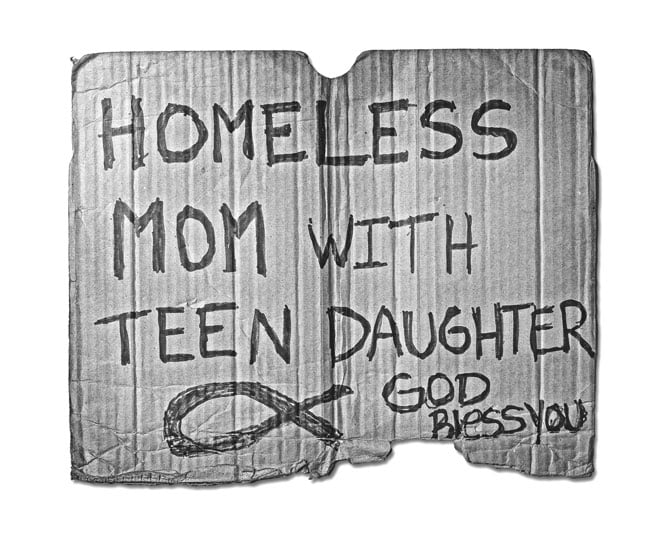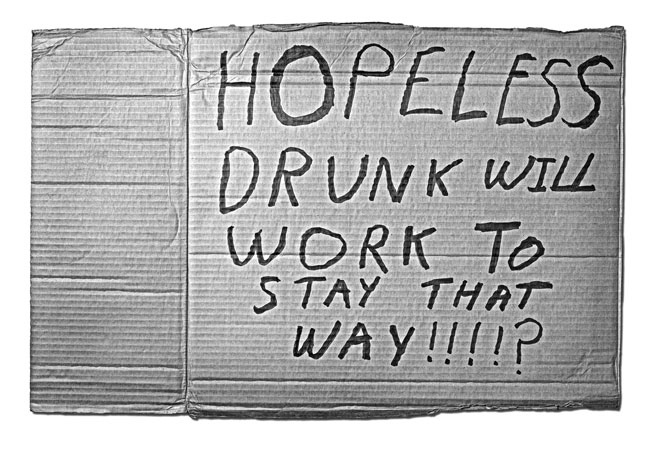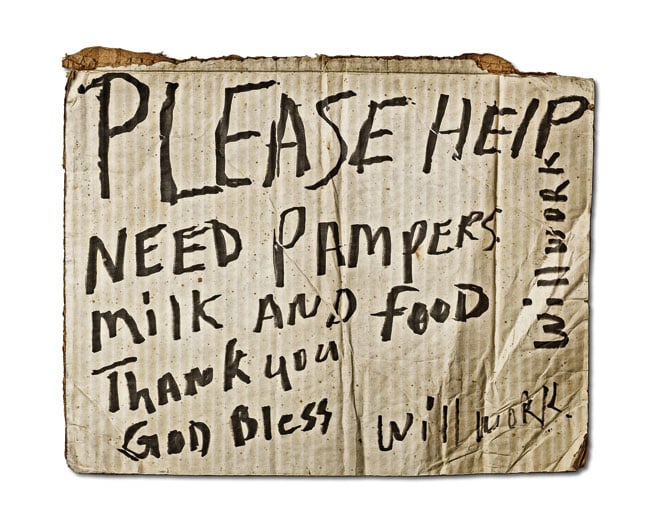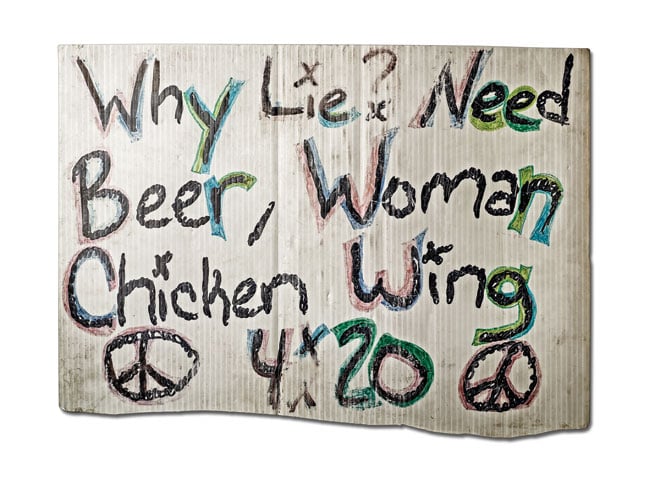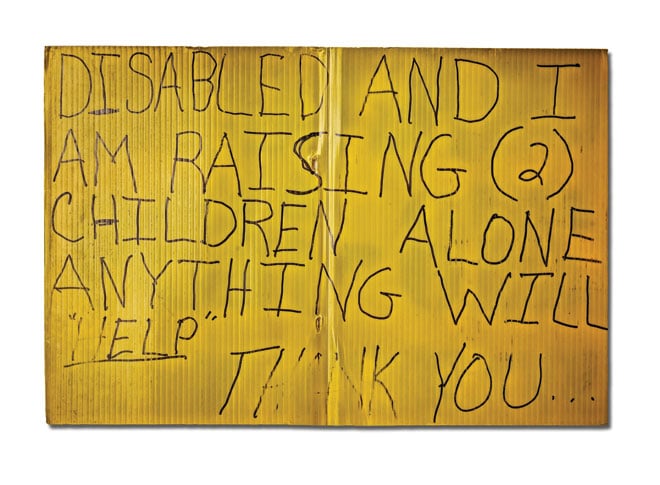Dateline
Free and Homeless
Homeless people holding signs are a part of the fabric of daily life. Beggars have been a part of society since the beginning of time. Using a sign to appeal for assistance probably began in England in Charles Dickens’ day when itinerates were dressed in sandwich boards to advertise certain establishments. Out-of-work people in the Great Depression expounded on that idea to advertise for food, work and anything to keep them alive. Many people became nomads during that time following rumors of work spread by others as desperate as themselves.
I grew up in Amarillo Texas up between Route 66 and the Rock Island Railroad tracks. Together these arteries connected the East with the West, with tributaries from coast to coast. Each day, the freight trains coming in would bring another load of drifters and hoboes, refugees from far away places, who would jump from the trains and disappear into the shadowy spaces in and around Amarillo. They would come to my parent’s back door and ask for work in exchange for something to eat. My mother would always give them work; weeding the garden, mowing the grass, painting the garage, any little job to secure the exchange of work for food.
I was curious about these vagabonds and wondered where they came from. They dressed in clothes from another time. They spoke in strange accents and used words I’d never heard. Their faces looked hard and tired but some of them had a certain twinkle in their eye. They looked as if they had seen some side of the world no one else had seen. Where did these men come from? Why did they not have a home? Where were they going?
I left home in the ’60’s when I was 17 years old with no destination other than to see the world. Neither the pump-jacks nor the cotton fields offered jack-shit to a restless musician like myself. School had not gone well. I had tried juggling three jobs; going to school, washing dishes in a fried chicken joint and playing music in the honky-tonks on the outskirts of town. It didn’t work. Late nights and early mornings did not mix. I said to hell with it.
I hit the road.
I traveled light. I had a backpack, a sleeping bag, a guitar and a piece of plastic for a tent to keep the rain away. I had no money, no plan and knew no one in any of the places that I was drawn to. I hitchhiked the highways from coast to coast. I was free. I was also homeless.
I got to know the freight train routes. I learned the rules; where to get on, where to get off, who to look out for, how to disappear, when to move, when not to move, how to avoid the yard bulls and where to sleep. I learned the little things.
It was the ’60’s. Who needed money? There was music in the air. I was drawn to the romance of the places in the songs; California Dreamin’; 59th Street Bridge Song; Penny Lane; Summer in the City. I followed the songs. I only worried about accommodations when I got to where I was going. In Venice California, I slept under the pier. I played guitar on the boardwalk for coins to buy something to eat or to pitch in on a bottle of Red Mountain Vin Rose. In San Francisco I slept in Golden Gate Park and made do with the generosity of the hippies.
It was the places in between that were hard; Albuquerque, Gallup, Yuma, and San Berdu in the West and Toledo, Akron, Pittsburgh and Newark in the East. In these towns, drifters were considered insurgents. Money was scarce. The recession was sharp. I got the feeling it was best to keep moving. The generosity of strangers allowed me to keep going. I reminded myself that I wasn’t homeless, I was free.
My songs and my guitar had given me a job. I was now homeless with a job. I had my hopes up high …
The big city was an eye opener. New York in the ’70’s was rough and tough. My friend, Laredo, and I slept on the Staten Island Ferry for the first week. The winter was settling in. The cold blew through our thin jackets. I played songs in the subway when it was too cold to play the streets. The cops ran us off. We came back. We slept in a warehouse prop-room for a while in exchange for sweeping out the theater down below. The winter kept coming on like a mad wolf.
It was in New York City that I first noticed written signs used by the blind. The signs, obviously written by someone else, would describe the condition of the person and appeal for mercy from the person walking by. A tin can served as the till. The worldly possessions of the pitiful one were scattered about within reach, covered in snow. The paralyzed, the crippled and the mentally ill huddled in doorways using signs to advertise their disability and to make a plea for financial assistance. New York was a hard son-of-a-bitch.
“GOD BLESS – †††– LUKE 6:30”
When the end of the Vietnam War collided with the recession of the ’70’s a new era of homelessness was ushered in. The Era of the Homeless Veteran. Fresh from a brutal war, the soldiers came back to America in shock. The war had become increasingly unpopular and had pushed the country to the edge of revolution. Many of the soldiers suffered from post traumatic stress and turned to drugs, glue and cheap booze to ease the pain. Signs emerged to create humility in the reader.
“HOMELESS USMC 1554 ‘1965-1970’ PLEASE HELP”
“VIETNAM VET – WILL WORK FOR FOOD.”
The signs were made with a marker scrawled on cardboard, like handmade scratches on wastepaper pulp. In some cases the signs were more visible than the person holding them. They were an attempt at a message to advertise a condition to inspire pity on patriotism. This theme has since had a resurgence every few years with the wars in the Persian Gulf, Bosnia, Afghanistan and Iraq.
I bought my first homeless sign in San Francisco in the mid-’70’s. An impulse urged me to offer five dollars for the sign. The guy looked at me with surprise. He wondered if I was on drugs. He was asking for spare change but was offered a buy-out. He jumped at the offer and scurried off to find materials to make a new sign.
“GOD IS GOOD, SO IS PEOPLE”
He had changed from beggar to advertising artist in the course of one transaction.
Over the years I kept buying the signs. The sign-people came out of the shadows and onto the back streets. In the ’80’s they went on from the back streets to the islands of major intersections. In the ’90’s the messages on the signs changed again from simple petitions into attempts at humor, sometimes pathetic, falling flat with a thud.
“WHY LIE, I NEED A DRINK”
“WIFE KIDNAPPED – SHORT 98 ¢ FOR RANSOM”
“NEED DOUBLE MOCHANONFAT LATTEAND A CHOCOLATE AMARETTOALMOND SCONE”
“NEED FUEL FOR MY LEAR JET”
Some went on to become true creative works of art. Some of the displaced sign painters began taking pride in their work and refused to sell their signs. One such man told me, “Sell you this sign, like hell, I made a hundred and eighty dollars with this sign yesterday!”
I took notes on the evolution of the signs, and, because I traveled constantly around the country, began to notice certain slogans showing up in cities thousands of miles from each other. Code words began to appear such as using the term 4:20 Time to advertise for spare marijuana. How could these desperados, who were cut off from worldly communication, come up with the same sayings?
The Rise of the Sign Pimp
At a busy intersection in Austin one day I asked a man if he would like to sell his sign.
“I can’t sell you this sign.”
“And why not?”
“This sign ain’t mine.”
“Do you mean someone issued you this sign?”
“I ain’t sayin’ …”
I was stunned. This meant that some pimp was hiring beat-up looking people, issuing them a sign, running off the real homeless from the busiest corners in the cities and installing their people to work the traffic all day long. I found out that at the end of the day the workers would turn in their signs, receive a minimum wage and, if lucky, return to work the next morning. Capitalist ingenuity at its worst.
The contrast between the migrant homeless and the status quo here in the world’s richest country is blatant. Big city dwellers walk past panhandlers every day with a brisk walk and eyes straight ahead. They never pause and never look back. To pause is to acknowledge the existence of the down and out. It is easier to walk on by.
Those who are comfortable in the manicured lawns of the suburbs stay close to their walled cities and away from the back streets. They keep their power windows shut and their doors locked when approached at an intersection.
They prefer the safety of shiny shopping centers where they can tell the difference between a pair of distressed Abercrombie jeans and the rags of a homeless man. Fashionable clothes full of rips and frays are inspired by gypsies and nomads with the irony being that young rich Americans will pay anything to dress like those more “experienced” than themselves.
Were the rise of the homeless signs a prophesy of global depression? Did they warn of the Big Loss? The happy face scrawled on filthy cardboard. Held by a raggedy unfortunate soul down on his luck. Perhaps he was once more fortunate than he is now. Safe in a purring car. Air-conditioner blowing a conditioned hair-do. Radio playing West Coast Jazz. Kids in the back playing with plastic war toys. Shooting at the bum on the curb.
Bang. Bang.
Mommy why doesn’t that man wash his face?
Why does he wear those dirty clothes?
Why is he holding that piece of cardboard?
Why is he standing in the middle of the street?
Has he been bad?
No one is really homeless. Home has always been a place of refuge inside oneself. But fear and anxiety can lead a drifter away from that refuge and on to a life of desperation. What is said on the signs is rarely the truth. Few could bear the truth. What is said is an advertisement. That life is hard. That bad luck happens. That wrong turns have been made. That survival itself is a realization of the need to be awake.
“HOMELESS JEDI – NEEDS NOTHING”
I’d like to offer a few dollars for that person’s sign. But the light just turned green.
Damn.
Life ain’t fair.
Excerpted from SIGNS, #39 in the Pentagram Papers, by Austin’s Pentagram Design. E-mail [email protected] for information.
Photographs by Randal Ford